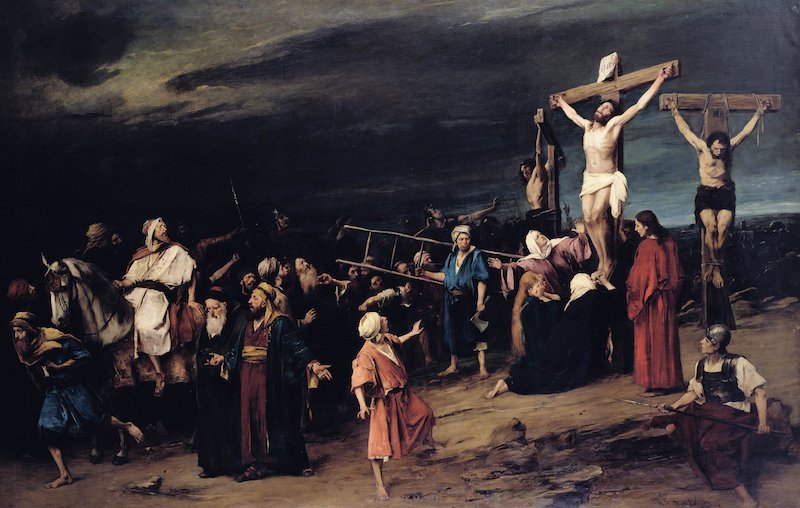It is the time of year Christians set aside to reflect on the death and resurrection of Jesus Christ — a story so familiar we might overlook some of the small but important details.
This year, we will point out details that often pass unnoticed, with a reflection on the important role they play in Christian faith more generally.
Normally, we think of the big events in Christ’s passion — the Last Supper, the trial, the mocking and scourging, the journey the crucifixion site with the cross on his back and finally, the death, burial, and resurrection themselves.
Those are the broad strokes of the story. But mixed in among those details are not just events, or generic stock characters playing the role of villain or bystander, but a series of specific names.
The gospel accounts were committed to paper (or parchment) just a few decades after the events they describe. The content that was written down was to make a formal permanent record of the oral tradition about the life and work of Jesus that was already being shared among the early church.
Besides Jesus and the Twelve, a series of people and places are explicitly mentioned by name.
We see place names like Gethsemene, Gabbatha (the Stone Pavement), the Potter’s Field, the Praetorium, and Golgotha, which would have been instantly recognizable to a local audience. And a detailed cast of named characters. :
- Caiaphas
- Herod
- Pilate
- Barabbas
- Simon of Cyrene
- His sons, Rufus & Alexander (Mark 15:21)
- Mary Magdelene, Mary (mother of James and Joseph), Salome
- Joseph of Arimathea
- Joanna
- Cleopas, on the road to Emmaus
- Annas, the father-in-law of Caiaphas, the high priest that year (with clues about the institutional power he holds at the temple despite his son-in-law holding the title) More about Annas & Caiaphas here.
- Nicodemus
John’s gospel, written later than the synoptics, is written after other apostles have been martyred. With Peter already killed, there is no risk in describing the details of the arrest of Jesus and Peter’s attempt to decapitate the servant of the priest, or Jesus’s subsequent healing that servant’s ear. (John 18:4-11)
We are given the servant’s name: Malchus.
Imagine for a moment that you are reading a report about something that happened at the 1996 Olympic Games in Atlanta. That report includes an account, claiming to be true, that includes the names of public figures that may have been in attendance, the President, perhaps, or a Governor. It mentions events and organizers. It names athletes by name, as well as organizers, judges, and staff.
This didn’t happen yesterday, but it’s not so far away in time or space that we can’t do some real digging into what did or didn’t really happen.
A historian wants to verify the accuracy of the account… what does he do? He looks at the list of place names and addresses mentioned to see if they are historically accurate. If that checks out, he’ll look at the public record — did they get the right President and Governor for the location and time period? Do the athletes referenced match up with the historical records? Nice. That gets you to plausibility, but it still stops short of conclusive proof.
What an investigator or historian would want to do next is track down eyewitnesses. If their account matches what the record says, it adds weight of credibility. Any conflict, blows big holes in the story.
How does that help us with the gospels?
A Greek-speaking author was able to provide the Aramaic names for local points of interest. He was able to correctly name relevant political leaders. He knew the name of the criminal released in Jesus’s place.
That would be like the account getting the politicans and the athletes right in our modern example. The gospel accounts take us further, and raise the stakes higher.
They mention the guy whose ear came off — a servant of the High Priest — by name.
They mention people sympathetic to person and work of Jesus: like Nicodemus, or the women who watched the crucifixion.
Each of the named people witnessed some aspect of Christ’s passion: his arrest, scourging, crucifixion, or resurrection. Some of those names (like Rufus and Alexander) went on to be known within the Christian community. Others, like Nicodemus, were known for a role in society.
With these people named, and friends and relatives still around, it wouldn’t be difficult to dispel bogus claims of someone playing a role in the crucifixion story.
But we have no record of such disclaimers — either from those within the faith, or the various critics of Christianity whose writings have survived.
Peter tried to take Malthus’s head off, but only managed to take his ear. The Jesus took a moment in the middle of his arrest to reattach it. It wouldn’t be hard for someone to ask him — did that really happen the way they said it did?
In the end, we will believe or reject not just on the evidence we have, but on our biases and prejudices for or against them… but sometimes, evidence can be compelling enough that even our staunchest biases aren’t enough to ignore it.
Lionhearted: Making Young Christian Males Rowdy Biblical Men
 Dear young Christian male, this book you’re about to read is meant to challenge you to your very core. Its intent is not to make you feel warm and fuzzy. Some of the chapters will upset you greatly, especially if you’re a dandy who was raised with kid gloves by a helicopter mommy.
Dear young Christian male, this book you’re about to read is meant to challenge you to your very core. Its intent is not to make you feel warm and fuzzy. Some of the chapters will upset you greatly, especially if you’re a dandy who was raised with kid gloves by a helicopter mommy.
That said, in addition to the holy introspection contained herein, this book will also shoot adrenaline into your soul. It’ll push you to be a Godly risk taker and earth shaker. A veritable Rebel With A Cause just like the Captain of Our Salvation, the Lord Jesus Christ.
If you want a feel-good book that tickles your ears and morphs you into a little Christian popinjay, this tome ain’t for you. You should put this book down and walk away from it immediately. However, if, young man, if … your motto is to give God your utmost for His highest, and you wanna live a life worthy of Christ’s death, then this book will be grist for your mill.
Get your copy of Lionhearted: Making Young Christian Males Rowdy Biblical Men TODAY!




